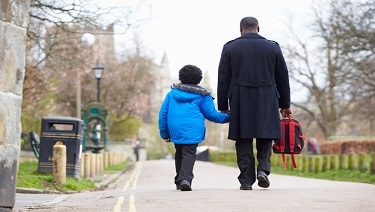When students walk to school, they're setting good habits and a positive tone for the day. Although distance, weather, and infrastructure can make walking challenging for some, those that do live within walking distance (typically 1 mile or less) can reap some amazing benefits from getting their stride on each day. Here are five ways walking to school can benefit your children and family.
1. Improve Test Scores
Adding just 20 minutes of physical activity (approximately the time it takes to walk a mile) into a child's day can increase test scores. In a 2015 study, researchers found that after just 20 minutes of physical activity students tested better in reading, spelling, and math and were more likely to read above their grade level. By having your child walk to and from school you can help them perform better.
2. Fewer Sick Days
Walking just 30 minutes a day can boost your child's immune system and cut their risk of catching a cold in half. Walking to school could mean fewer sick days for your child and fewer missed work days for you.
3. Improve Mental Health
With mental health issues rising in children throughout the past decade, it's important to find small ways to combat these issues and improve mental health on a daily basis. During the coronavirus (COVID-19) pandemic, children have been sheltered from their normal interactions with peers such as playing during recess and the overall social aspect of being in person. Walking can help to reduce the severity of mental health issues. Just an hour of physical activity a day can help reduce stress and reduce depression and anxiety.
4. Improve Sleep
Sleep is crucial for children and teens who are developing both mentally and physically, but unfortunately students, especially teenagers, can have issues with sleep and often don't get a good night's rest. Walking to school can help children and teens sleep more soundly and improve their sleep quality. Getting an adequate amount of sleep in turn can contribute to higher test scores, better moods and behavior, and improved mental and physical health.
5. It's Good For You, Too!
It's advised that children under ten are walked to school by a parent, trusted adult, or as a part of a walkpool (similar to carpools but walking instead of driving). By walking your child to school, you can reap the health benefits that walking brings as well. Walking just 30 minutes a day can reduce the risk of diabetes, heart disease, depression, certain cancers, Alzheimer's and dementia, osteoporosis while improving fatigue, blood pressure, strength, and boosting endorphins and the immune system. Walking your child to school can make you healthier and happier!
Worried About Safety?
Safety can be a big concern for many parents when it comes to walking to school. Parents can ensure their child is safe by helping them understand and obey traffic signs and signals. Walking in groups and adopting a buddy system can also increase safety. Walkers should also avoid using electronics that could distract them during their route.
In addition, the District's Safe Routes to Schools program works year-round to advance safe walking and biking to and from schools and address problem areas. DC's Safe Passage initiative has also identified safe spot locations that are local stores and businesses known to welcome students who encounter safety issues on their way to and from school. Find safe spot locations along your route to school.
WRITTEN BY: goDCgo
goDCgo is an initiative of the District Department of Transportation (DDOT) that encourages the use of sustainable transportation. We provide complimentary transit resources and consulting services to DC organizations and commuters. Our goal serves to decrease traffic congestion, improve air quality and create a better quality of life in the DC area.








